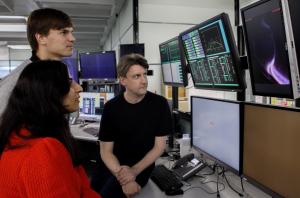A helium campaign kicks off at JET
After achieving record-breaking results on the Joint European Torus during 2021 experiments with the high-performance fuel mix of deuterium and tritium, EUROfusion researchers are turning to helium in a campaign intended to inform ITER operation.
ITER will begin operation with non-activating fuels (i.e., hydrogen and helium) as part of the Pre-Fusion Power Operation phase designed to commission all tokamak, plant and auxiliary systems with plasma (up to 15 MA current) to their highest performance and to acquire critical operational experience before moving on to full power.
"An essential element of the ITER Research Plan is to explore control of the plasma interaction with the wall in a high confinement operation scenario," explains Head of Science & Operation Tim Luce. "This needs to be addressed already in the initial research phases before deuterium and tritium are used to produce fusion power in ITER."
The characterization of key plasma parameters in L-mode and H-mode, the development of plasma scenarios, the exploration of different modes of operation, and the achievement of key physics goals (e.g., power load control and ELM control) are also part of this initial phase on ITER.
JET*, with its ITER-like beryllium wall and tungsten-clad divertor, is an ideal test bed to verify the physics models of plasma-wall interaction and modelling tools for ITER. In a press release issued today, EUROfusion researchers say they will study the behaviour of the helium plasmas as well as test the impact of helium on ITER-like plasma-facing components, acting as a risk-mitigator for ITER.
"While it is expected to be easier to reach [a high confinement operation scenario] in helium rather than hydrogen in these initial phases, we need to know that what we learn in helium would be relevant to deuterium-tritium operation," says Luce. "We have great expectations of how these upcoming experiments can help us optimize the ITER Research Plan to move as efficiently as possible into deuterium-tritium operation."
Fernanda Rimini, JET Senior Exploitation Manager, said the new research underway is one more way that the JET tokamak is helping make fusion energy a reality. "After breaking the record for sustained energy last year, these important new experiments will prove more science and provide crucial data for the ITER team as they prepare for larger-scale operations, ultimately saving time and money on our roadmap to delivering fusion power to the grid."
The new experimental campaign started on 1 September 2022 and is expected to last for up to 16 weeks.
See the original EUROfusion press release.
*The Joint European Torus (JET) has been operated at the Culham Centre for Fusion Energy as a Joint Undertaking of the European Community since 1977 and operated under the United Kingdom Atomic Energy Authority (UKAEA) since 2000. Today the JET facilities are collectively used by researchers, staff and students from European fusion laboratories under the EUROfusion consortium (30 member institutes and 152 associated entities).


